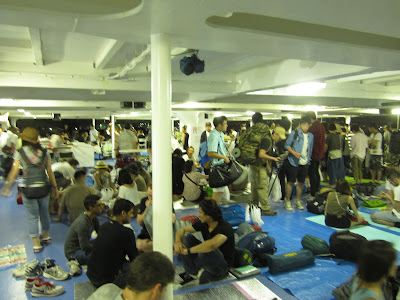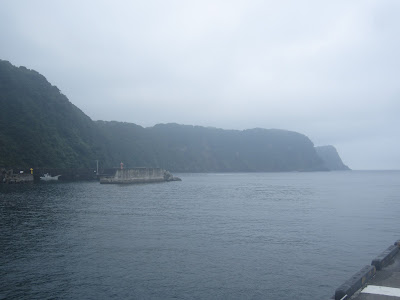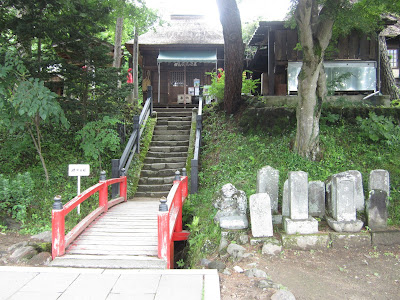Good day everyone,
has it already been two weeks, again? Sorry for not sticking to my schedule again. I originally planned to visit Hakone last weekend but cancelled in the last minute due to an unfavorable weather forecast. I then postponed the trip to the following weekend, which was a great idea. The weather conditions weren't the best to see Mt. Fuji but I was finally able to see something resembling a volcano.
Hakone is a volcanic complex of overlapping calderas and a spot with a great view of Mt. Fuji. It is highly active due to the numerous fumaroles (I hope you still know what that is). The dispersion of volcanic gas is so bad that all the hiking trails are closed. However, you're still allowed to take the cable car to the top of the valley containing all the fumaroles. And damn, the smell was awful. Usually you can go down into the valley but because of the increased discharge rate of the gases it is closed to the public. You're only allowed to watch from afar. The first thing you notice while going up with the cable car is the sulfuric smell, next you'll see the flora changing, then you'll hear something resembling a jet engine (I shit you not, those things are really loud). After that the cable car crests the ridge and goes right over the valley. There you see huge patches of yellow sulfur and a gazillion fumaroles. It was really incredible. Here are some pictures.
 |
| Can you here the jet engine? |
 |
| The flora doesn't really like the smell either. |
As I mentioned, this a a great spot to see Mt. Fuji from. Lo and behold, I was actually able to see it too.
 |
| That thing is quite massive. |
Fuji obviously sticks out from its surroundings with a summit of 3776 m above sea level. Hakone is not small either with its 1438 m, but doesn't come close. Can't wait to finally climb that bugger in two weeks.
After taking the cable car down to the other side of the mountain I proceeded to take a "pirate" ship across the lake. Yes, a pirate ship. I don't even want to know either. Anyway, here goes...
 |
| Lake Ashinoko |
 |
| The lake and pirate ship. |
On this side of the lake there used to be one of the great roads connecting Kyoto and Edo (Tokyo), named Tokaido. There used to be a guarded checkpoint during the reign of the Tokugawa shogunate. Its purpose was to control everybody going into the capital as well as keeping the women from leaving. You might ask why they would do such a thing. One of the reasons that the Tokugawa shogunate was able to hold Japan together was their way of ensuring loyalty from the other feudal lords. The lords (or daimyos) were required to come to Edo every other year and stay there for a while. Their family however had to stay in Edo indefinitely. This ensured that the daimyos never had enough time or resources to plan a rebellion, since traveling to Edo by foot with their whole household was quite a task. If they however would rebel, their family would be held hostage or be killed.
After the fall of the shogunate in the 19th century, these kinds of checkpoints where not needed anymore and fell into ruin. The checkpoint here at Hakone was faithfully reconstructed and serves as an open air museum. Here are some pictures.
 |
| Entrance coming from Edo. |
 |
| Interesting way of building. |
 |
| The inside. |
 |
| View from the watchtower. |
 |
| The view of the lake is nothing to be sniffed at. |
The next stop was Hakone shrine. A little shrine hidden in the woods with a pathway from the shore of the lake up to the shrine itself. The lower end of the path literally starts in the water and is marked by a shinto gate (I learned that they are actually called "
Torii"-gates, but you know what I mean by now). Pictures from this gate and the lake with the snowy summit of Mt. Fuji in the background are quite famous, nothing I was able to recreate though. Anyway, here are some pictures.
 |
| Fuji is covered by clouds. |
 |
| The beginning of the pathway. |
 |
| The path. |
 |
| Hakone shrine. |
I was really blown away by the beauty of Hakone. The whole area is mountainous and the villages are all based on the slopes. It's incredibly picturesque. Here is a little train station to give you a glimpse.
 |
| Miyanoshita station. |
I was really happy that I decided to visit from Friday to Saturday since the weather on Saturday was, well, sub optimal:
 |
| Going over the valley with the fumaroles. I could at least smell them. |
 |
| The same location from before... |
I think I am cursed.
On this weekend there also was the Tsukuba festival (Matsuri Tsukuba). So. Many. People.
I came to see the parade. Here, every community in the Tsukuba area presents their own wagon. There are lots of shows, music, dancing and whatnot. Quite an experience.
 |
| This wagon was towed buy a lot of children. |
 |
| Even nicer in the dark. |
 |
| These lanterns were balanced buy people using one hand or their chins. |
There were also a lot of drums and flutes. I really enjoyed the music.
The amount of food booths was astronomical. I quickly found my favorite though:
 |
| Mmmmhhhhhh, Yakisoba. |
Next I'll go to Hokkaido for 5 days. See you then.
Nils



































































